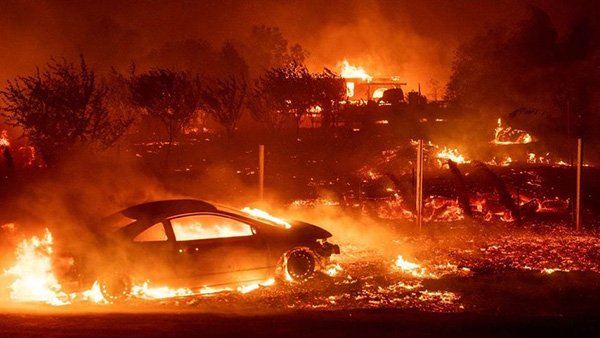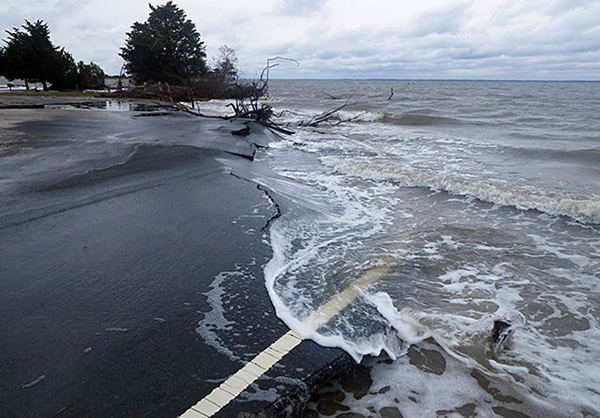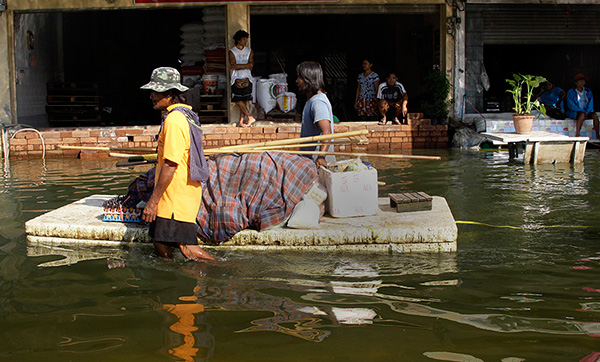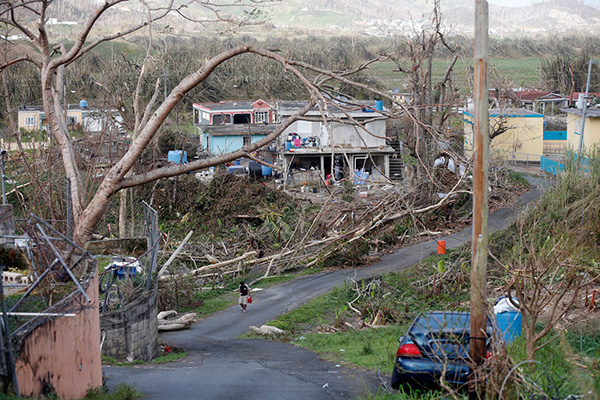On the New U.S. Climate Report: A Dire Warning from the Scientific Community
| Revolution Newspaper | revcom.us

Glaciers and snow cover are shrinking, and sea ice is retreating as seen here at Muir Glacier, Alaska. (Photos: William O. Field, August 13, 1941 and Bruce F. Molnia, August 31, 2004)
“Earth’s climate is now changing faster than at any point in the history of modern civilization, primarily as a result of human activities. The assumption that current and future climate conditions will resemble the recent past is no longer valid.” These are the first words of a major report the U.S. government just released which shines a light on the horrific impact of climate change today and in the near future.
Impacts, Risks, and Adaptation in the United States: Fourth National Climate Assessment (NCA4) was produced by 300 experts from government, indigenous communities, national laboratories, and universities. It has been approved by 13 federal agencies.
A Dire Future
If greenhouse gas emissions continue to rise at the present rate, the future world we will face will be grim, according to the report. Almost every sector of U.S. society and economy including air and water, forests, agriculture, power, transportation, biodiversity, the infrastructure, the coastline, urban and rural areas, health, and much more will be transformed. Andrew Light, an author of the report and a Senior Fellow at the World Resources Institute, said that if there is not a significant reduction in carbon dioxide (CO2) emissions, “We’re talking about hundreds of thousands of lives every year that are at risk because of climate change. And hundreds of billions of dollars.”
The report states clearly that because of climate change our future on the planet will be very different than it is at present. “The ecological resources that people depend on for livelihood, protection, and well-being are increasingly at risk,” according to the report, “and future generations can expect to experience and interact with natural systems that are much different than those that we see today.”
- Wildfires, which are already taking a horrific toll, will increase greatly in number and intensity. According to the report, burned areas in Southern California could double by 2050. In the Southeast, wildfires would also increase and intensify—as they have been in California and the West—drowning large parts of the country—not just the West—in toxic air.
- In the Arctic, annual average temperatures have increased more than twice as fast as the global average according to the report. The report predicts that “by mid-century, it is very likely that the Arctic will be nearly free of sea ice in late summer.”
- The report says that Atlantic and eastern North Pacific hurricane rainfall and intensity are projected to increase as will storm surge. Nearly five million people in the U.S. live in communities that are within four feet of the local high-tide level. If current trends continue, huge swathes of the Atlantic coast—from North Carolina to Maine—will see sea-level rise of five feet by 2100, making the coastline unrecognizable and forcing millions to relocate.
- Agricultural production in the Midwest will be disrupted. The report predicts that climate change could result in the production of corn and soybeans and other crops falling by 25 percent from current levels.
- Oceans will become more acidic and warmer, damaging ocean ecosystems. This has already led to mass bleaching of coral reefs and outbreaks of coral diseases off the coasts of Puerto Rico, the Virgin Islands, Florida and Hawaii.
- Health will be directly impacted under current climate projections. According to the report in 49 large cities in the United States, changes in extreme hot and extreme cold temperatures are projected to result in more than 9,000 additional premature deaths per year by the end of the century.
- Lyme disease-carrying ticks and mosquitoes that transmit viruses such as Zika, West Nile, and dengue will spread to new areas, causing new outbreaks of these diseases.
- The Northeast habitat for the Asian tiger mosquito, which spreads West Nile virus, will expand by a factor of ten by the end of the century, “exposing more than 30 million people to the threat of dense infestations by this species,” according to the assessment.
- Importantly, the report emphasizes that it looks at ways that the results of climate change can interact, magnifying the risk. “Impacts affecting interconnected systems can cascade across sectors and regions, creating complex risks and management challenges,” the climate assessment says. “For example, changes in the frequency, intensity, extent, and duration of wildfires can result in a higher instance of landslides that disrupt transportation systems and the flow of goods and services within or across regions.”
- “Most climate studies have considered only relatively gradual, continuous changes in the Earth’s climate system,” the report says. “However, there are a number of potential ‘tipping points’ in the climate system—points where a threshold is crossed, resulting in a substantial change in the future state of the climate system, regionally and/or globally.”
While NCA4 contains much new information and analysis which we should learn from, it is marred by basic methodological and political problems. It largely takes as its focus the impact that climate change is having on the U.S. economy, the U.S. military, and the U.S. position in the world, often reducing impacts to crudely financial terms. One of many examples is when the report cites severe flooding in Thailand in 2011, which resulted in 815 deaths and disrupted the lives of 13.6 million people, and caused great damage to the environment. This is treated not as a humanitarian and environmental crisis—instead the report talks about how the supply chains for U.S. electronics companies were affected.
It is absurd and profoundly wrong—and not scientific—to look at something like the oceans from the point of view of what the U.S. can get out of them. Oceans—and fundamentally the entire natural world—are something that humanity should leave in better condition for future generations of people and plant and animal life everywhere.
Climate Change Is Now
The previous U.S. climate assessment, issued just four years ago, largely spoke of climate change as something in the future and the worst outcomes as something future generations would see. This new climate assessment incorporates a great deal of scientific advances and also a lot of new investigation and work. For example, it notes that because of scientific advances it is now possible to see how climate change is behind many of the extreme weather-related events of recent years (such as hurricanes, floods, drought, wildfires, tornadoes, and heat waves), and it brings out example after example from many parts of the U.S. of how this is happening.
“High temperature extremes and heavy precipitation events are increasing. Glaciers and snow cover are shrinking, and sea ice is retreating. Seas are warming, rising, and becoming more acidic, and marine species are moving to new locations toward cooler waters,” the authors write. “Flooding is becoming more frequent along the U.S. coastline. Growing seasons are lengthening, and wildfires are increasing. These and many other changes are clear signs of a warming world.”
According to the report, in just the last three years, the United States has experienced 44 major climate-related disasters with more than $400 billion in damages. Tornadoes that struck the Midwest in March 2017, wildfires in the Western states, the 2017 Atlantic hurricane season (which destroyed much of Puerto Rico), the 2017 drought that caused $2.5 billion in agricultural damage in the Northern Great Plains, and many other events all can be linked to climate change.
The report brings out the disproportional harm that climate change is bringing to poor communities and especially to indigenous people. For example, in Louisiana, the tribal community of Isle de Jean Charles is being forced to move in response to severe land loss, sea level rise, and coastal flooding. They have lived on the island since 1830 when they moved there to escape the “Indian Removal Act.” The same factors are also forcing tribal communities to be displaced in Alaska.
Trump Attacks the Report
The Trump administration’s response to an extensively researched, 1,600-page report prepared by government agencies and scientists and which warns of profound disruptions to society, is cover-up and dismissal. It attempted to bury the report by releasing it on Black Friday. One of the report’s editors said, “They dropped the report on Black Friday, and you know it’s the press who calls releasing anything on a Friday afternoon ‘taking out the trash’—this was burning it and burying it in the backyard.”
The New York Times ran a major article discussing the fact that the Trump administration had considered rewriting the report, or blocking it in other ways, but had decided instead to issue it as written as an official government report, and then just ignore and deny everything it said and refuse to carry out even the mild measures that the report advocates. The former head of the Environmental Protection Agency under Bush 1, William Reilly, said “This is a new frontier of disavowance of science, of disdain for fact.”
“No. No. I don’t believe it,” was Trump’s first response, three days after the report’s release. Sarah Sanders and commentators on Fox News said that the report is only based on worst case scenarios—which a ten-second glance at the report would refute.
The fact that the report WAS written and then released without being changed despite the open and well-known intense hostility and hatred of the Trump regime to climate science and science in general points in part to how there are scientists and environmental advocates throughout the government who are not folding in the face of the attacks but continuing to fight even within the government for a scientific approach. And the report, and its treatment by the regime, have been taken up by ruling class forces like the New York Times and the Democratic Party to take pokes at Trump. These ruling class forces agree that human activity is causing climate change, admit that many of its impacts are real, and claim to want to stop it. But despite the fact that the existence of human civilization could be at stake in how people respond to climate change, they have NO ANSWER, constrained by the very workings and imperatives of the system they preside over. (See sidebar.)
We Must Stop Capitalism-Imperialism from Destroying the Planet
The National Climate Assessment has revealed much about the extent of the climate catastrophe that mankind faces and what we will face if the trajectory is not reversed.
“It shows us that climate change is not a distant issue. It’s not about plants, or animals, or a future generation. It’s about us, living now,” Katharine Hayhoe, an author of the report and an atmospheric scientist at Texas Tech University told the Guardian.
We must act NOW, with the urgency that the situation demands, to fight against the devastation caused by climate change, and work to make revolution, to put an end to the capitalist-imperialist system, and stop the destruction of the planet.
The Destruction of the Planet by Capitalism-Imperialism
Share widely on social media
This video clip is from Bob Avakian's speech Why We Need An Actual Revolution And How We Can Really Make Revolution. Watch the speech and learn more about it here.

Wildfires have ravaged California in recent years. This October the Camp Fire burned 153,000 acres, almost completely destroying the town of Paradise, population 27,000. 19,000 buildings, including 13,970 homes, burned. As of November 28, 88 people are confirmed dead and 196 are still missing. (Photos: AP)

Seas are warming, oceans are rising, flooding is becoming more frequent along the U.S. coastline. Shown: Assateague Island. (Photo: National Park Service)

Oceans are becoming more acidic and warmer, damaging ecosystems. This has already led to mass bleaching of coral reefs and outbreaks of coral diseases. (Photo: NOAA/David Burdick)

In 2011, severe flooding in Thailand resulted in 815 deaths, and disrupted the lives of 13.6 million people, more than a fifth of the country's population. (Photo: AP)

In 2017 Hurricane Maria destroyed much of Puerto Rico. (Photo: AP)
CONSTITUTION For The New Socialist Republic In North America
(Draft Proposal)
Authored by Bob Avakian, and adopted by the Central Committee of the RCP
Get a free email subscription to revcom.us:


